Australia Water Treatment Chemicals Market Size
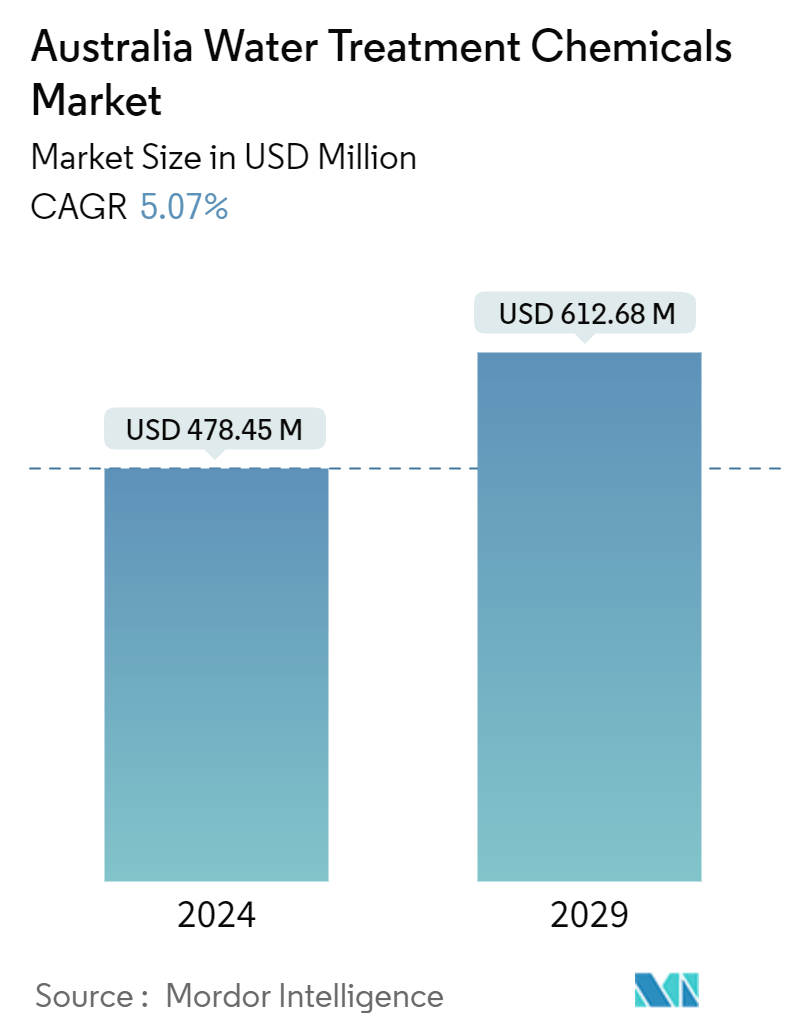
| Study Period | 2019 - 2029 |
| Base Year For Estimation | 2023 |
| Market Size (2024) | USD 478.45 Million |
| Market Size (2029) | USD 612.68 Million |
| CAGR (2024 - 2029) | 5.07 % |
| Market Concentration | High |
Major Players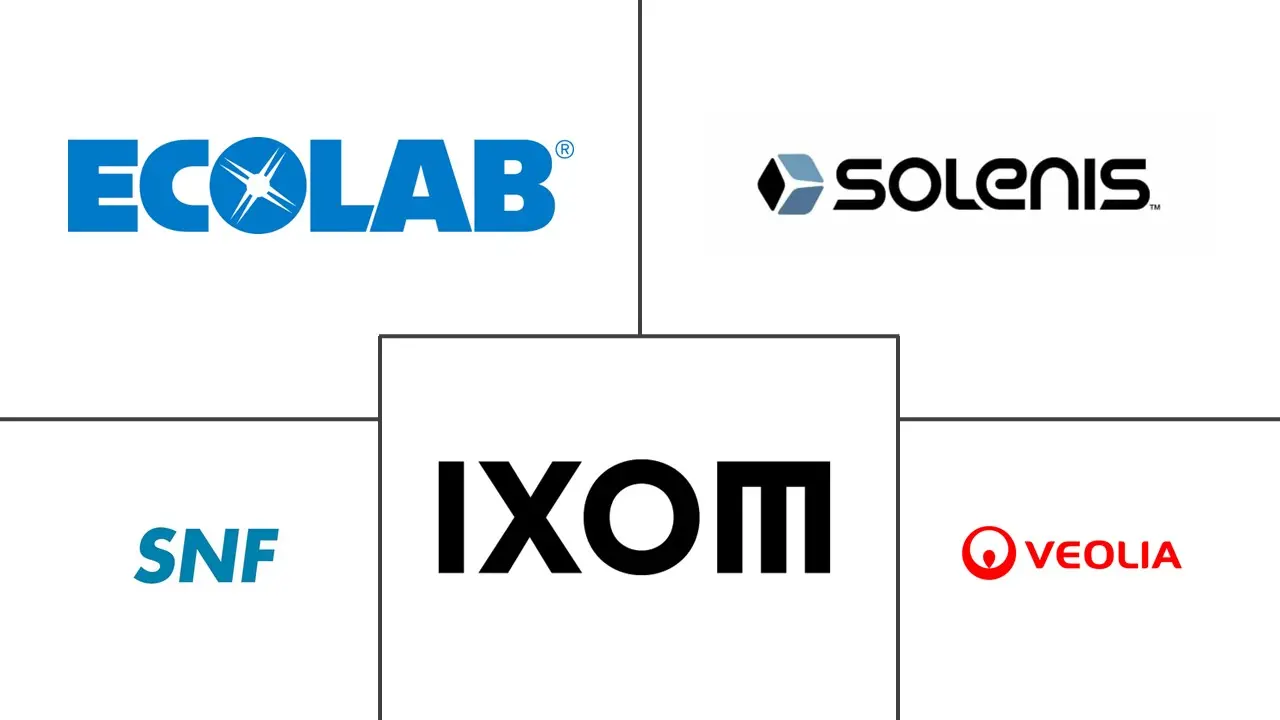
*Disclaimer: Major Players sorted in no particular order |
Australia Water Treatment Chemicals Market Analysis
The Australia Water Treatment Chemicals Market size is estimated at USD 478.45 million in 2024, and is expected to reach USD 612.68 million by 2029, growing at a CAGR of 5.07% during the forecast period (2024-2029).
- Rising ground and surface water pollution, growing demand from power and industrial applications, and government intervention in reliable wastewater management are expected to boost the water treatment chemicals market in Australia.
- However, the hazardous nature of hydrazine and emerging alternatives to water treatment chemicals are expected to hinder the market's growth.
- Nevertheless, the shifting focus toward green chemicals is likely to create lucrative growth opportunities for the market studied.
- The municipal segment is expected to be the largest end-user industry by registering rapid growth over the forecast period.
Australia Water Treatment Chemicals Market Trends
Corrosion and Scale Inhibitors to Dominate the Market
- Corrosion inhibitors are general-purpose chemicals that deal with corrosion in boilers. Corrosion occurs when oxygen reacts with metallic parts in a boiler to form oxides. Corrosion affects the metallic parts of the boiler, thereby increasing the costs of energy and maintenance. Corrosion inhibitors form a thin barrier layer over the exposed parts of the boiler. Scale inhibitors are used to remove scales through chemical processes.
- Several types of corrosion inhibitors are used in water boilers. These include condensate line corrosion inhibitors, diethyl hydroxyl amine (DEHA), polyamine, morpholine, cyclohexylamine, and carbon dioxide corrosion inhibitors. A mixture of filming amines is used to prepare condensate line corrosion inhibitors. This can provide protection due to the presence of both high and low vapor/liquids.
- DEHA is a volatile compound that is also an oxygen scavenger and acts as a metal passivating agent. Polyamine can be used in both low and high-pressure boilers. Morpholine protects the boiler by increasing the pH level of the liquid. Cyclohexylamine is used in low-pressure boilers. Carbon dioxide corrosion inhibitor is used along with polyamine to control corrosion.
- The aforementioned inhibitors are also used in cooling water treatments to ensure metal protection and prevent metal loss. The absence of these inhibitors may lead to critical system failures in recirculating water piping, process cooling equipment, and heat exchangers. Corrosion inhibitors are added to treatment systems to protect metals by reducing the corrosion potential associated with the cathode and anode of the corrosion cell.
- The most serious form of corrosion occurs in cooling water treatment systems containing steel and copper alloys. Multi-phase processes, such as pretreatment, coagulation, flocculation, and corrosion control, occur during water treatment. Among these processes, the corrosion inhibitor is added after filtration to avoid fouling. As a countermeasure, corrosion inhibitors are added to prolong the service life of piping throughout a water distribution system.
- Furthermore, corrosion inhibitors are among the key chemicals used in the oil and gas industry. Corrosion inhibitors are the backbone of a strong asset integrity program that keeps equipment failure rates in check. They are used to safeguard wells, pipelines, tanks, compressors, and practically every other type of downhole or surface equipment. Oil and gas producers, transporters, and refiners would suffer greatly if corrosion inhibitors were inaccessible.
- The growing demand for solutions to avoid corrosion during processing across various end-user industries leads to the demand for corrosion inhibitors, which leads to the growth of the market studied.
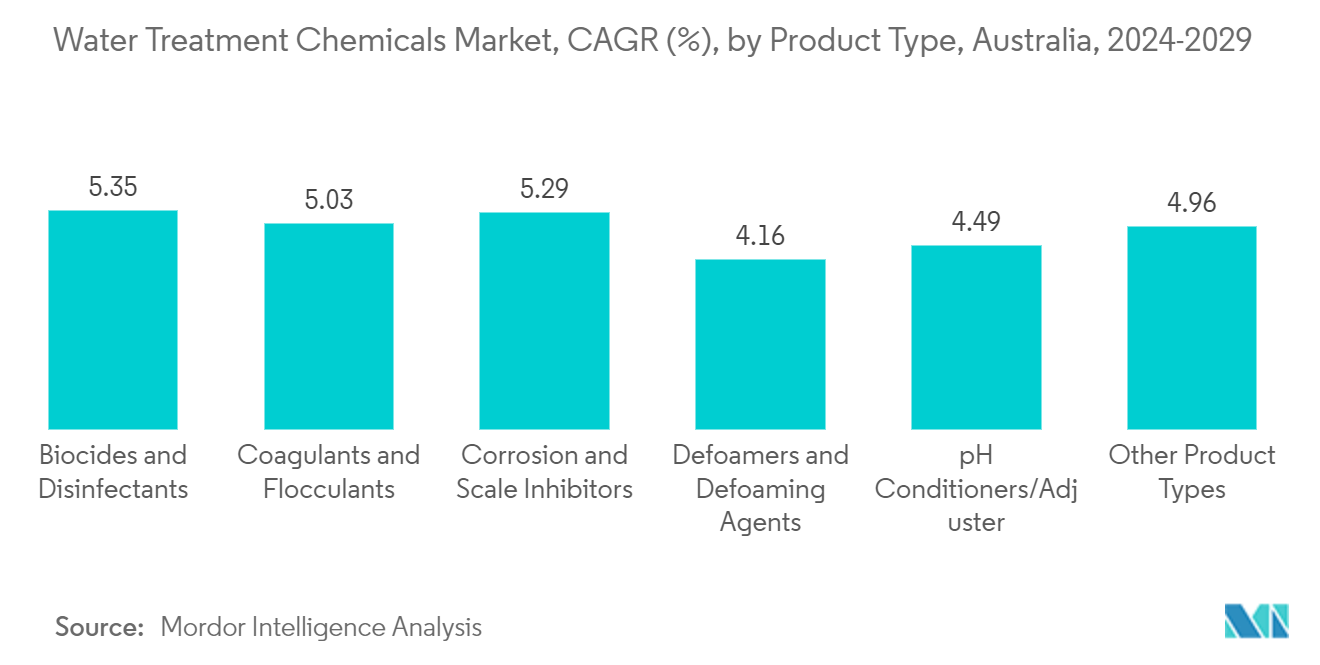
Municipal End-user Industry to Dominate the Market
- The supply of pure water to households is one of the primary requirements for all governments. The rising scarcity of potable water, coupled with the growing population and increasing water demand, is driving the demand for the water treatment chemicals market in Australia.
- Municipal wastewater is water drained from toilets, showers, sinks, bathrooms, washing machines, dishwashers, and liquid industrial waste. It should be treated before it is released into the environment to avoid environmental damage and the spreading of harmful diseases.
- The major treatment technologies include preliminary treatment, primary and secondary treatment, tertiary treatment, biological nutrient removal (BNR), resource recovery, and energy generation.
- Australia's 2023-24 budget allocated significant funds to bolster the National Water Grid Authority, with USD 79.0 million earmarked over an 11-year span. Additionally, USD 197.1 million was reallocated over six years (starting 2023-24) to support three critical water infrastructure projects: the Northern Midlands Irrigation Scheme, the Sassafras-Wesley Vale Irrigation Scheme in Tasmania, and the Quality Water for Wannon project in Victoria.
- With a population of 26 million, Australia boasts a high water connectivity rate, with 94% linked to the primary water supply. The nation has approximately 300 urban water utilities, with a notable concentration. Notably, 22 utilities serve 70% of the population, while the remaining 200 serve the rest, a figure that is even lower than the customer base of Sydney Water, Australia's largest utility.
- Australia's annual water usage stands at around 26,000 gigaliters, translating to roughly 1.3 million liters per person. Despite being the driest inhabited continent and having access to less than 1% of the world's freshwater resources, Australia's water consumption ranks among the highest globally. This demand is further exacerbated by the country's growing population.
- Around 85% of the population currently has access to more than 700 community sewage treatment plants. Nearly half of these are based on biological filters, about 170 are lagoons, and 45 are based on primary treatment. Most new plants are implementing activated sludge processes.
- Hence, owing to the above-mentioned factors, the municipal segment accounts for a significant share of the water treatment chemicals market in Australia and is expected to fuel the growth of the market studied during the forecast period.
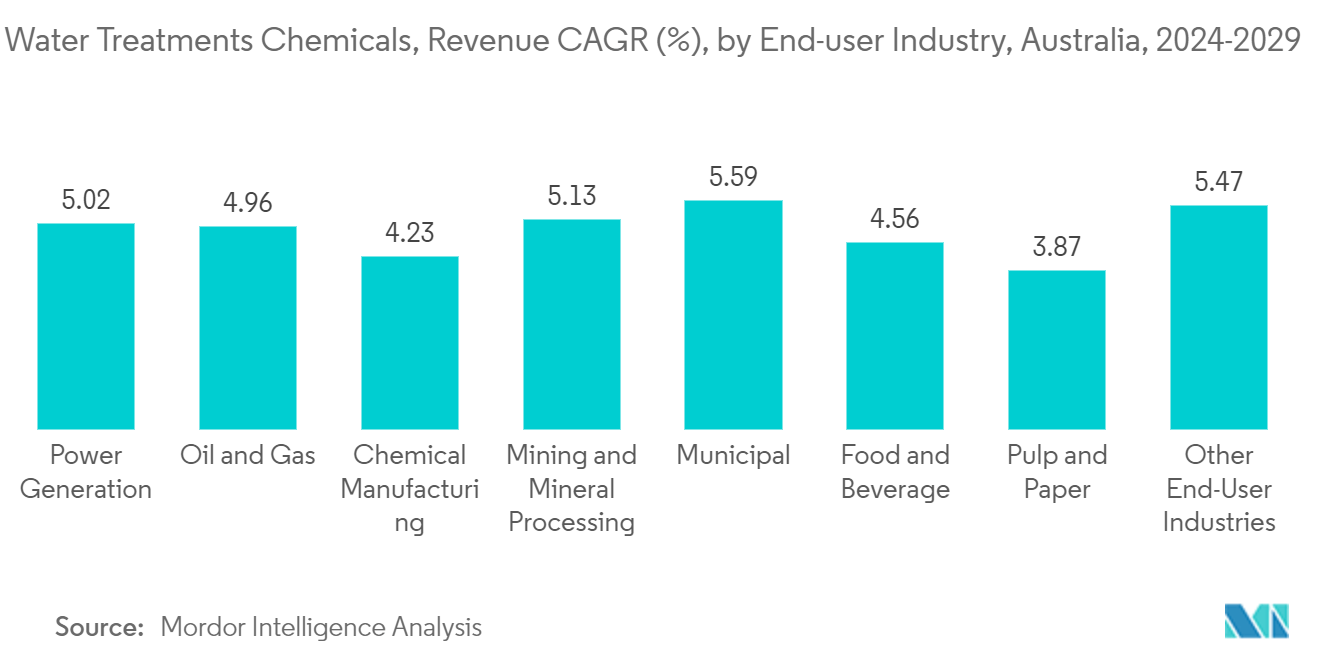
Australia Water Treatment Chemicals Industry Overview
The Australian water treatment chemicals market is highly consolidated. Some of the major players (not in any particular order) include Veolia (Veolia Water Technologies), Ecolab, Solenis, SNF, and Ixom.
Australia Water Treatment Chemicals Market Leaders
-
Veolia (Veolia Water Technologies)
-
Ecolab
-
Solenis
-
SNF
-
Ixom
*Disclaimer: Major Players sorted in no particular order
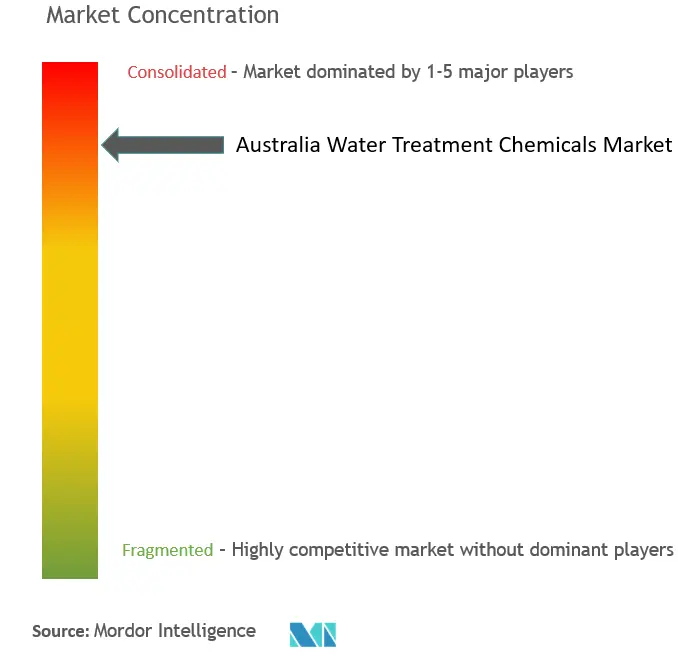
Australia Water Treatment Chemicals Market News
- September 2023: Waterco, a water treatment manufacturer, acquired Davey Water Products Pty Ltd (Davey) from GUD Holdings Limited (GUD). This move is pivotal in Waterco's strategic roadmap, aiming to solidify its position as a leading global player in the water technology sector. The acquisition not only sets the stage for sustainable growth but also primes Waterco to capitalize on evolving market prospects.
- June 2022: Kemira Oyj announced a new collaboration with a France-based company, Veolia, to launch a new technology named ViviMag. This technology can recover phosphorus and other valuable resources, such as iron, from sewage sludge. Phosphorus causes the overfertilization of the surface waters if not removed properly, causing a major environmental problem. This new technology will help Kemira OYJ strengthen its position in the water treatment sector.
- April 2022: Veolia Group announced a partnership with Sydney Water to explore innovation opportunities for the development of a robust circular economy, which will help to deliver sustainable and resilient water services to the city.
Australia Water Treatment Chemicals Market Report - Table of Contents
1. INTRODUCTION
1.1 Study Assumptions
1.2 Scope of the Study
2. RESEARCH METHODOLOGY
3. EXECUTIVE SUMMARY
4. MARKET DYNAMICS
4.1 Market Drivers
4.1.1 Rising Groundwater and Surface Water Pollution
4.1.2 Growing Demand From Power and Industrial Applications
4.1.3 Increasing Government Intervention in Reliable Wastewater Management
4.2 Market Restraints
4.2.1 Hazardous Nature of Hydrazine
4.2.2 Emerging Alternatives to Water Treatment Chemicals
4.3 Industry Value Chain Analysis
4.4 Porter's Five Forces Analysis
4.4.1 Bargaining Power of Suppliers
4.4.2 Bargaining Power of Buyers
4.4.3 Threat of New Entrants
4.4.4 Threat of Substitute Products and Services
4.4.5 Degree of Competition
5. MARKET SEGMENTATION
5.1 By Product Type
5.1.1 Biocides and Disinfectants
5.1.2 Coagulants and Flocculants
5.1.3 Corrosion and Scale Inhibitors
5.1.4 Defoamers and Defoaming Agents
5.1.5 pH Conditioners/Adjusters
5.1.6 Other Product Types
5.2 By End-user Industry
5.2.1 Power Generation
5.2.2 Oil and Gas
5.2.3 Chemical Manufacturing
5.2.4 Mining and Mineral Processing
5.2.5 Municipal
5.2.6 Food and Beverage
5.2.7 Pulp and Paper
5.2.8 Other End-user Industries
6. COMPETITIVE LANDSCAPE
6.1 Mergers, Acquisitions, Joint Ventures, Collaborations, and Agreements
6.2 Market Ranking Analysis
6.3 Strategies Adopted by Leading Players
6.4 Company Profiles
6.4.1 Albemarle Corporation
6.4.2 Aquasol
6.4.3 Buckman
6.4.4 Coogee
6.4.5 De.mem-Capic Pty. Ltd
6.4.6 Dow
6.4.7 Ecolab
6.4.8 IWTS Group Pty. Ltd
6.4.9 Ixom
6.4.10 Kemira Oyj
6.4.11 SNF
6.4.12 Solenis
6.4.13 Solvay
6.4.14 Veolia (Veolia Water Technologies)
6.4.15 Waterco
- *List Not Exhaustive
7. MARKET OPPORTUNITIES AND FUTURE TRENDS
7.1 Shifting Focus Toward Green Chemicals
Australia Water Treatment Chemicals Industry Segmentation
Water treatment is a process that extracts or reduces the level of pollutants and undesirable components from water to make it suitable for use. The chemicals used in this method are referred to as water treatment chemicals. Algicide, chlorine, and chlorine dioxide are some examples of water treatment chemicals.
The water treatment chemicals market is segmented by product type and end-user industry. By product type, the market is segmented into biocides and disinfectants, coagulants and flocculants, corrosion and scale inhibitors, defoamers and defoaming agents, pH conditioners/adjusters, and other product types. By end-user industry, the market is segmented into power generation, oil and gas, chemical manufacturing, mining and mineral processing, municipal, food and beverage, pulp and paper, and other end-user industries. For each segment, the market sizing and forecasts have been done on the basis of value (USD).
| By Product Type | |
| Biocides and Disinfectants | |
| Coagulants and Flocculants | |
| Corrosion and Scale Inhibitors | |
| Defoamers and Defoaming Agents | |
| pH Conditioners/Adjusters | |
| Other Product Types |
| By End-user Industry | |
| Power Generation | |
| Oil and Gas | |
| Chemical Manufacturing | |
| Mining and Mineral Processing | |
| Municipal | |
| Food and Beverage | |
| Pulp and Paper | |
| Other End-user Industries |
Australia Water Treatment Chemicals Market Research FAQs
How big is the Australia Water Treatment Chemicals Market?
The Australia Water Treatment Chemicals Market size is expected to reach USD 478.45 million in 2024 and grow at a CAGR of 5.07% to reach USD 612.68 million by 2029.
What is the current Australia Water Treatment Chemicals Market size?
In 2024, the Australia Water Treatment Chemicals Market size is expected to reach USD 478.45 million.
Who are the key players in Australia Water Treatment Chemicals Market?
Veolia (Veolia Water Technologies), Ecolab, Solenis, SNF and Ixom are the major companies operating in the Australia Water Treatment Chemicals Market.
What years does this Australia Water Treatment Chemicals Market cover, and what was the market size in 2023?
In 2023, the Australia Water Treatment Chemicals Market size was estimated at USD 454.19 million. The report covers the Australia Water Treatment Chemicals Market historical market size for years: 2019, 2020, 2021, 2022 and 2023. The report also forecasts the Australia Water Treatment Chemicals Market size for years: 2024, 2025, 2026, 2027, 2028 and 2029.
Water Treatment Chemicals in Australia Industry Report
The Australia Water Treatment Chemicals Market Report offers a comprehensive industry overview and market analysis, segmented by product type and end-user industry. This industry report covers biocides and disinfectants, coagulants and flocculants, corrosion and scale inhibitors, defoamers and defoaming agents, pH conditioners/adjusters, and other product types. The end-user industries include power generation, oil and gas, chemical manufacturing, mining and mineral processing, municipal, food and beverage, pulp and paper, and other industries.
The market forecast outlook provides insights into the market growth and market trends, highlighting the market leaders and their market share within the industry. The report also includes industry statistics and market data, offering a detailed industry analysis and market review.
This market report is an essential resource for understanding the industry size, market value, and market segmentation. It provides a historical overview and market predictions, giving a clear picture of the market outlook and industry trends. The report example and report PDF are available for download, providing an in-depth industry research and industry information.
With a focus on industry sales and market growth, this report is valuable for research companies looking for comprehensive market data and industry research. The industry outlook and market forecast are crucial for understanding the future direction of the water treatment chemicals market in Australia.



